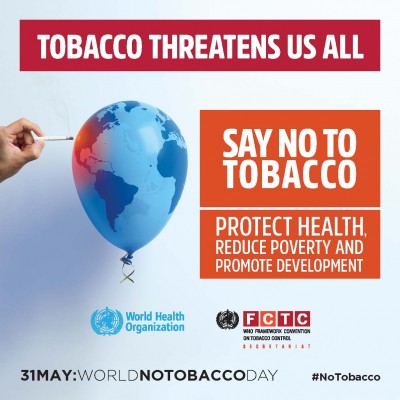World No Tobacco Day, 31 May 2017
Tobacco – a threat to development
Every year, on 31 May, WHO and partners mark World No Tobacco Day (WNTD), highlighting the health and additional risks associated with tobacco use, and advocating for effective policies to reduce tobacco consumption.
The theme for World No Tobacco Day 2017 is "Tobacco – a threat to development."
About the campaign
- It will demonstrate the threats that the tobacco industry poses to the sustainable development of all countries, including the health and economic well-being of their citizens.
- It will propose measures that governments and the public should take to promote health and development by confronting the global tobacco crisis.
Goals of the World No Tobacco Day 2017 campaign
- Highlight the links between the use of tobacco products, tobacco control and sustainable development.
- Encourage countries to include tobacco control in their national responses to 2030 Sustainable Development Agenda.
- Support Member States and civil society to combat tobacco industry interference in political processes, in turn leading to stronger national tobacco control action.
- Encourage broader public and partner participation in national, regional and global efforts to develop and implement development strategies and plans and achieve goals that prioritize action on tobacco control.
- Demonstrate how individuals can contribute to making a sustainable, tobacco-free world, either by committing to never taking up tobacco products, or by quitting the habit.
Tobacco control supports health and development
WHO is calling on countries to prioritize and accelerate tobacco control efforts as part of their responses to the 2030 Agenda for Sustainable Development.
All countries benefit from successfully controlling the tobacco epidemic, above all by protecting their citizens from the harms of tobacco use and reducing its economic toll on national economies. The aim of the Sustainable Development Agenda, and its 17 global goals, is to ensure that "no one is left behind."
Tobacco control has been enshrined in the Sustainable Development Agenda. It is seen as one of the most effective means to help achieve SDG target 3.4 of a one-third reduction globally, by 2030, of premature deaths from noncommunicable diseases (NCDs), including cardiovascular disease, cancers and chronic obstructed pulmonary disease. Strengthening implementation of the WHO Framework Convention on Tobacco in all countries is an additional target to be met by governments developing national sustainable development responses.
Controlling tobacco helps achieve other global goals
In addition to saving lives and reducing health inequalities, comprehensive tobacco control contains the adverse environmental impact of tobacco growing, manufacturing, trade and consumption.
Tobacco control can break the cycle of poverty, contribute to ending hunger, promote sustainable agriculture and economic growth, and combat climate change. Increasing taxes on tobacco products can also be used to finance universal health coverage and other development programs of the government.
It is not only governments who can step up tobacco control efforts: people can contribute on an individual level to making a sustainable, tobacco-free world. People can commit to never take up tobacco products. Those who do use tobacco can quit the habit, or seek help in doing so, which will in turn protect their health as well as people exposed to second-hand smoke, including children, other family members and friends. Money not spent on tobacco can be, in turn, used for other essential uses, including the purchase of healthy food, healthcare and education.
Facts about tobacco, tobacco control and the development goals
- More than 7 million deaths from tobacco use every year, a figure that is predicted to grow to more than 8 million a year by 2030 without intensified action. Tobacco use is a threat to any person, regardless of gender, age, race, cultural or educational background. It brings suffering, disease, and death, impoverishing families and national economies.
- Tobacco use costs national economies enormously through increased health-care costs and decreased productivity. It worsens health inequalities and exacerbates poverty, as the poorest people spend less on essentials such as food, education and health care. Some 80% of premature deaths from tobacco occur in low- or middle-income countries, which face increased challenges to achieving their development goals.
- Tobacco growing requires large amounts of pesticides and fertilizers, which can be toxic and pollute water supplies. Each year, tobacco growing uses 4.3 million hectares of land, resulting in global deforestation between 2% and 4%. Tobacco manufacturing also produces over 2 million tonnes of solid waste.
- The WHO Framework Convention on Tobacco Control (WHO FCTC) guides the global fight against the tobacco epidemic. The WHO FCTC is an international treaty with 180 Parties (179 countries and the European Union). Today, more than half the world’s countries, representing nearly 40% of the world’s population (2.8 billion people), have implemented at least one of the WHO FCTC’s most cost-effective measures to the highest level. An increasing number of countries are creating firewalls to ward off interference from the tobacco industry in government tobacco control policy.
- Through increasing cigarette taxes worldwide by US$1, an extra US$190 billion could be raised for development. High tobacco taxes contribute to revenue generation for governments, reduce demand for tobacco, and offer an important revenue stream to finance development activities.
Reference: http://www.who.int/campaigns/no-tobacco-day/2017/event/en/





